 W
WAgalychnis is a genus of tree frogs native to forests in Mexico, Central America and northwestern South America.
 W
WAgalychnis buckleyi is a species of frog in the family Phyllomedusidae. It is found in Colombia and Ecuador. Its natural habitats are subtropical or tropical moist lowland forests, subtropical or tropical moist montane forests, and freshwater marshes. It is threatened by habitat loss.
 W
WAgalychnis dacnicolor, the Mexican leaf frog, is a species of frog in the family Phyllomedusidae. It is endemic to Mexico.
 W
WThe blue-sided leaf frog, also known as the orange-eyed leaf frog, is an endangered tree frog of the family Phyllomedusidae native to the tropical rainforests of Costa Rica and Panama.
 W
WCallimedusa tomopterna, the tiger-striped leaf frog, is a species of frog in the family Phyllomedusidae. It is found in northern South America in the Upper Amazon Basin of Bolivia, Peru, Ecuador, and Colombia, Amazonian Brazil, and the Guianas from southeastern Venezuela to French Guiana. It might represent more than one species.
 W
WCruziohyla is a genus of frogs in the family Phyllomedusidae. They occur from Honduras in Central America south to the Amazon Basin in South America. This genus was erected in 2005 following a major revision of the Hylidae and fully reviewed in 2018. Species in this genus were previously placed in the genera Agalychnis or Phyllomedusa.
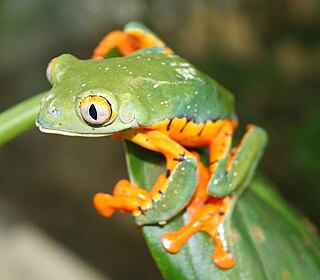 W
WCruziohyla calcarifer, the splendid leaf frog or splendid treefrog, is a tree frog of the family Phyllomedusidae described in 1902 by George Albert Boulenger. It has a distribution from Esmeraldas Province in northwestern Ecuador, through western Colombia and Panama to the most southerly part of Costa Rica. It is a nocturnal, arboreal frog inhabiting primary humid lowland forest.
 W
WHylomantis is a genus of tree frogs, the rough leaf frogs, native to the Atlantic forest in eastern Brazil. There are two recognized species; several others formerly placed in this genus now are placed in Agalychnis.
 W
WHylomantis aspera is a species of frog in the family Phyllomedusidae. It is endemic to Brazil. Its natural habitats are subtropical or tropical moist lowland forests, swamps, and intermittent freshwater marshes. It is threatened by habitat loss.
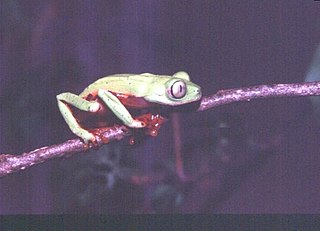 W
WPhasmahyla is a genus of tree frogs. They are commonly known as shining leaf frogs.
 W
WPhasmahyla cochranae, sometimes called the chocolatefoot leaf frog, is a species of frog in the family Phyllomedusidae. It is endemic to Brazil. Its natural habitats are subtropical or tropical moist lowland forests, subtropical or tropical moist montane forests, and rivers. It is threatened by habitat loss.
 W
WPhasmahyla spectabilis is a species of frog in the family Phyllomedusidae. It is endemic to Brazil.
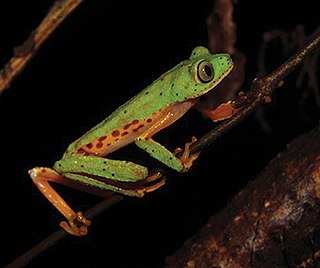 W
WPhasmahyla timbo is a species of frog in the family Phyllomedusidae. It is endemic to Brazil.
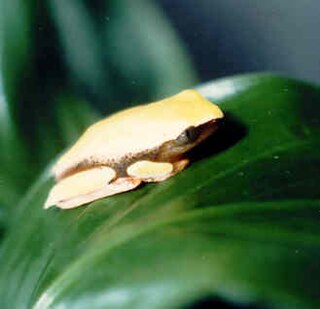 W
WPhrynomedusa marginata, the bicolored leaf frog, is a species of frog in the family Phyllomedusidae. It is endemic to Brazil. Its natural habitats are subtropical or tropical moist lowland forests, rivers, and intermittent rivers. It is threatened by habitat loss.
 W
WPhyllomedusa is a genus of tree frogs in the family Phyllomedusidae from tropical and subtropical South America and Panama. It has 16 recognised species.
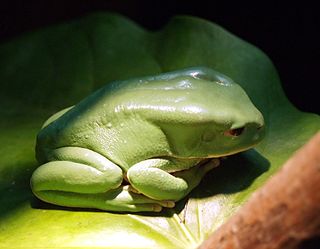 W
WPhyllomedusa boliviana is a species of frog in the family Phyllomedusidae. It is found in Argentina, Bolivia, and Brazil . Its natural habitats are subtropical or tropical moist lowland forests, subtropical or tropical moist montane forests, intermittent freshwater marshes, and ponds. It is threatened by habitat loss.
 W
WPhyllomedusa burmeisteri, also known as Burmeister's leaf frog and common walking leaf frog is a species of frog native to the Atlantic Forest biome in Brazil.
 W
WPhyllomedusa camba is a species of frog in the family Phyllomedusidae. It is found in Bolivia, Brazil, and Peru.
 W
WPhyllomedusa distincta is a species of frog in the family Phyllomedusidae, endemic to Brazil. Its natural habitats are subtropical or tropical moist lowland forests and freshwater marshes. It is threatened by habitat loss.
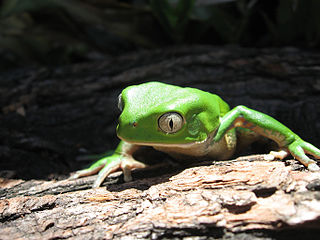 W
WPhyllomedusa iheringii is a species of frog in the family Phyllomedusidae, found in Brazil and Uruguay. Its natural habitats are temperate shrubland and intermittent freshwater marshes, and is threatened by habitat loss.
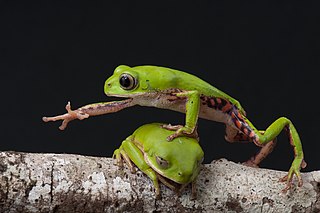 W
WPhyllomedusa rohdei is a species of frog in the family Hylidae. It is endemic to Brazil. Its natural habitats are subtropical or tropical moist lowland forests, moist savanna, rivers, arable land, pastureland, plantations, rural gardens, urban areas, and heavily degraded former forests.
 W
WPhyllomedusa tarsius, also known as the tarsier leaf frog, is a species of frog in the family Phyllomedusidae. It is found in Brazil, Colombia, Ecuador, Peru, and Venezuela, and possibly Bolivia and Guyana. Its natural habitats are subtropical or tropical moist lowland forests, subtropical or tropical swamps, intermittent freshwater marshes, and heavily degraded former forest. It is threatened by habitat loss.
 W
WPhyllomedusa tetraploidea is a species of frog in the family Phyllomedusidae found in Argentina, Brazil, and Paraguay. Its natural habitats are subtropical or tropical moist lowland forests, freshwater marshes, pastureland, and heavily degraded former forest. It is threatened by habitat loss.
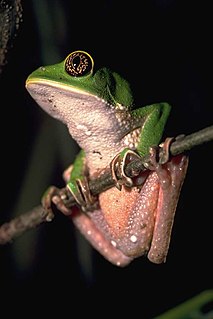 W
WPhyllomedusa trinitatis is a species of frog in the family Phyllomedusidae. It is found in Trinidad and Tobago and Venezuela. Its natural habitats are subtropical or tropical moist lowland forests, subtropical or tropical moist montane forests, moist savanna, subtropical or tropical moist shrublands, freshwater marshes, heavily degraded former forests, ponds, and canals and ditches. It is threatened by habitat loss.
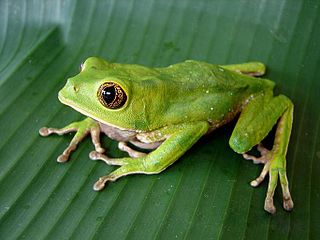 W
WPhyllomedusa venusta is a species of frog in the family Phyllomedusidae, found in Colombia and Panama. Its natural habitats are subtropical or tropical dry forests, subtropical or tropical moist lowland forests, swamps, freshwater marshes, intermittent freshwater marshes, and heavily degraded former forests. It is threatened by habitat loss.
 W
WPhyllomedusidae is a family of frogs found in the Neotropics commonly called leaf frogs. Alternatively, they are often considered as a subfamily of the family Hylidae, the tree frogs.
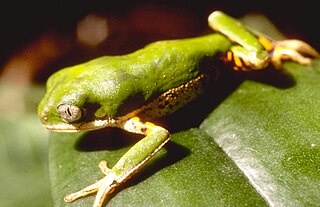 W
WPithecopus hypochondrialis, the northern orange-legged leaf frog or tiger-legged monkey frog, is a species of frog in the family Phyllomedusidae found in South America. Its natural habitats are subtropical or tropical dry forests, subtropical or tropical moist lowland forests, subtropical or tropical moist shrubland, subtropical or tropical seasonally wet or flooded lowland grassland, intermittent freshwater marshes, pastureland, plantations, rural gardens, urban areas, and heavily degraded former forests.
 W
WPithecopus oreades is a species of frog in the family Phyllomedusidae, endemic to the Brazilian savanna. Its natural habitats are subtropical or tropical dry shrubland, subtropical or tropical dry lowland grassland, and rivers.
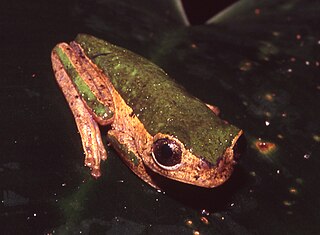 W
WPithecopus palliatus is a species of frog in the family Phyllomedusidae. It is found in Bolivia, Brazil, Ecuador, Peru, and possibly Colombia. Its natural habitats are subtropical or tropical moist lowland forests and intermittent freshwater marshes. It is threatened by habitat loss.
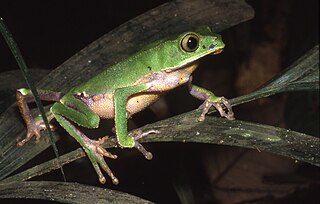 W
WThe white-lined leaf frog is a species of frog in the family Phyllomedusidae. It is found in northern South America. Its natural habitats are subtropical or tropical moist lowland forest, subtropical or tropical swampland, rivers, and freshwater marshes. It is threatened by habitat loss.